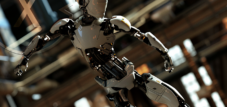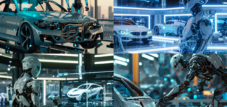Published on: July 8, 2025 / update from: July 8, 2025 - Author: Konrad Wolfenstein
Catalyst Humanoid technology: How human-like robots set new standards in industry
Technological revolution through humanoids: Why human -like robots determine the future of automation
Robotics are at a crucial turning point, and the development of humanoid robots is driving innovative technologies that go far beyond their original application. These human -like robots act as catalysts for technological breakthroughs that revolutionize the entire robotics industry and set new standards.
Suitable for:
The importance of humanoid robots as an innovation driver
The development of humanoid robots goes beyond the mild imitation of human movements. It represents a complex technological challenge that forces researchers and engineers to develop innovative solutions in various key areas. These innovations then find their way into the entire robotics industry and improve the performance of all robot types.
Humanoid robots are produced in series by 2025, and their development already has measurable effects on the robotics industry. Technological advances in humanoid robotics have improved by impressive 35 to 40 percent between 2023 and 2025, which illustrates the rapid innovation speed.
Artificial intelligence as a core component of the robotics revolution
The integration of artificial intelligence into humanoid robots has initiated a paradigm shift in the entire robotics industry. These AI-controlled systems are no longer limited to pre-programmed tasks, but can learn independently and adapt to new situations. The development of AI algorithms for humanoid robots has led to advanced systems that can now be used in various robot types.
Generative AI, which was originally developed for humanoid robots, now enables all robot types to be programmed with natural language. This technology eliminates the need for special programming knowledge and makes robots accessible to small and medium -sized companies. The robot manufacturers have recognized that the AI systems developed for humanoid robots can simplify the programming of all robot types.
AI research for humanoid robots has also led to significant progress in predictive maintenance. This technology analyzes performance data from robots to predict future failures and reduce maintenance costs. In the automotive supply industry, every unplanned lesson causes costs of around $ 1.3 million, which underlines the immense economic importance of these innovations.
Sensors and perception systems: groundbreaking developments
The development of advanced sensors for humanoid robots has led to groundbreaking innovations that are used in the entire robotics industry today. Humanoid robots need high -precision sensors for environmental perception, balance and manipulation, which has led to the development of new sensor technologies.
The visual systems developed for humanoid robots include RGB cameras, deep cameras, lidar, radar and ultrasonic sensors. These technologies enable robots to record and analyze their surroundings in real time. For example, Tesla Optimus uses a multi-camera setup similar to that in Tesla vehicles, while Boston Dynamics' Atlas combines various sensor technologies.
The development of tactile sensors for humanoid robots has led to a new generation of strength sensors that are used in the entire robotics industry. These sensors enable robots to measure forces and pressures and react accordingly, which is particularly important in human-robot collaboration.
Revator technology: precision and efficiency
The development of humanoid robots has led to significant progress in actuator technology. Humanoid robots need between 16 and 60 degrees of freedom, which has promoted the development of highly precise and efficient actuators. These technologies now find their way into all robot types and significantly improve their performance.
The development of electrical actuators for humanoid robots has led to a new generation of engines that have a high performance density, low mass and compact dimensions. Progress in permanent magnets, in particular neodyme-iron-Bor magnets, have significantly increased the power-density of electrical engines and reduced the distance to hydraulic systems.
Boston Dynamics' decision to operate the new Atlas completely electrically signals a trend towards commercialization and wider applicability. This development has an impact on the entire robotics industry, since electrical actuators have higher efficiency (75-80%) and require a lower maintenance effort than hydraulic systems.
Material sciences and structural design
The development of humanoid robots has led to innovative lightweight structures that are decisive for the flexibility, energy saving and longer battery life. Methods of evolutionary structural optimization (ESO) have been developed to reduce the weight of framework structures by over 50 percent without affecting rigidity or vibration behavior.
The materials developed for humanoid robots such as magnesium alloys and plastic resins are now widely used in the entire robotics industry. These materials make it easier to construct robots more easily, stronger and more energy -efficient.
Navigation systems and algorithms
The development of humanoid robots has led to advanced navigation systems that are now used in mobile robots of all kinds. The slam algorithms developed for humanoid robots (simultaneous localization and mapping) enable robots to determine their position at the same time and to create a map of their surroundings.
The combination of lidar and image processing-based systems that was originally developed for humanoid robots offers a robust performance in different scenarios. This hybrid navigation technology uses the strengths of both technologies and improves the ability of robots to understand and react to them.
Security standards and norms
The development of humanoid robots has led to a revision of the security standards in the entire robotics industry. The revised ISO 10218 standard defines new robot classes and extended safety requirements. These standards take into account the new skills and applications created by humanoid robots.
The security technologies developed for humanoid robots, especially in human-robot collaboration, have led to the development of ISO TS 15066 for collaborative robots. This standard determines which limit values for strength and speed must be observed in collaborative operation.
Effects on industrial robotics
The innovations from humanoid robotics have revolutionized industrial robotics. Modern industrial robots benefit from the advanced AI systems that were originally developed for humanoid robots. This integration enables industrial robots to monitor and signal their accuracy and performance when maintenance is required.
The image processing systems developed for humanoid robots have led to intelligent gripping systems that are widespread in industrial robotics. These systems can recognize, sort and manipulate objects without the need for complex programming.
Suitable for:
- The AI-controlled robotics and humanoid robots: hype or reality? A critical analysis of the market maturity
Economic effects and market development
The innovations from the humanoid robotics have significant economic effects on the entire robotics industry. Goldman Sachs estimates that the global market for humanoid robots will reach a volume of $ 38 billion by 2035. This development drives investments in the entire robotics industry and promotes further innovations.
The technologies developed for humanoid robots have reduced the costs for all robot types. High -quality robot systems have reduced their prices by 40 percent within one year, which promotes the spread of robot technology in small and medium -sized companies.
Human robot collaboration
The development of humanoid robots has led to groundbreaking progress in human-robot collaboration. The security systems and interaction interfaces developed for humanoid robots have promoted the development of collaborative robots (cobots). These technologies enable robots to safely work with people and to adapt to their needs.
The advanced sensors and AI systems developed for humanoid robots have led to the development of intuitive human-robot interfaces. These systems can understand human gestures and voice commands and react accordingly.
Future prospects and technology transfer
The innovations from the humanoid robotics will continue to shape the entire robotics industry. The development of generative AI models for humanoid robots will lead to even more intelligent and autonomous robot systems. These technologies will be able to solve complex tasks and adapt to new situations.
The technologies developed for humanoid robots are also used in new areas of application. The soft robotics, which was originally developed for humanoid applications, are now widely used in medical robotics and other sensitive areas.
Challenges and solutions
The development of humanoid robots has also led to innovative solutions for common challenges in the robotics industry. Cyber security, which is of crucial importance for humanoid robots, has led to the development of new security standards such as IEC 62443. These standards protect industrial automation systems from cyber attacks and are used in the entire robotics industry.
The energy management systems developed for humanoid robots have led to more efficient battery technologies that are used in mobile robots of all kinds. These innovations extend the operating time and reduce maintenance requirements.
Humanoid robots as an innovation driver: from AI to sensors
The development of humanoid robots has proven to be a powerful driver of innovation for the entire robotics industry. From advanced AI systems to precise sensors to efficient actuators-the technologies developed for humanoid robots improve the performance of all robot types. These innovations have not only expanded the technical possibilities, but also improved the economic accessibility of robot technology.
The future of robotics will be significantly shaped by the innovations that arise from humanoid robotics. With the expected series production of humanoid robots from 2025, these technologies will be available even more and will enable further breakthroughs in the entire robotics industry. The humanoid robotics therefore acts not only as an independent field of research, but as a catalyst for the further development of the entire robotics industry.
Investments in humanoid robots therefore pay off far beyond their original area of application. They create an ecosystem of innovations that promote the entire robotics industry and open new opportunities for automation, productivity and human-robot interaction. These technologies will fundamentally change the way we work, produce and interact with machines.
Suitable for:
Your global marketing and business development partner
☑️ Our business language is English or German
☑️ NEW: Correspondence in your national language!
I would be happy to serve you and my team as a personal advisor.
You can contact me by filling out the contact form or simply call me on +49 89 89 674 804 (Munich) . My email address is: wolfenstein ∂ xpert.digital
I'm looking forward to our joint project.














